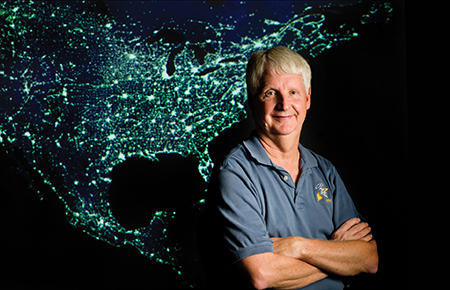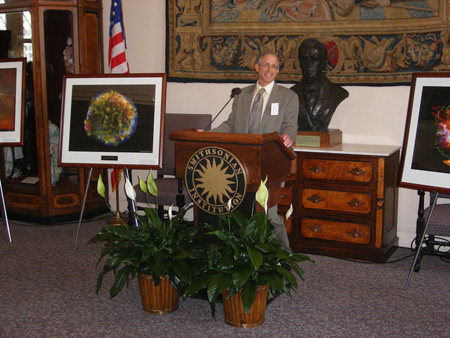Submitted by chandra on Mon, 2015-03-23 10:52
Steve Hawley was the flight engineer on the STS-93 Columbia mission that carried Chandra into space in 1999. Before that he was on four previous shuttle flights, one in 1990 to deploy the Hubble Space Telescope, and one in 1997 to assist in making major upgrades and repairs to Hubble. His role in the deployment of two of the most productive telescopes ever has secured him an important place in the history of astronomy.
At a recent symposium celebrating 15 years of Chandra Science, Steve sat down over breakfast to talk about his illustrious career so far, and plans for the future.
 Steve Hawley
Steve HawleyWhen did you first think you wanted to be an astronaut?
SH: I wanted to be astronomer since I was very young. My grandfather taught physics at a small college in Kansas. He used to say, "In physics, you learn how to think." In astronomy you can learn how the universe works just by looking. And I was drawn to become an astronaut NASA, because NASA is a great organization because they try to do things that have never been done before.
Submitted by chandra on Thu, 2015-01-22 09:56

The year of 2015 has been declared the International Year of Light (IYL) by the United Nations. Organizations, institutions, and individuals involved in the science and applications of light will be joining together for this yearlong celebration to help spread the word about the wonders of light.
In many ways, astronomy uses the science of light. By building telescopes that can detect light in its many forms, from radio waves on one end of the "electromagnetic spectrum" to gamma rays on the other, scientists can get a better understanding of the processes at work in the Universe.
Submitted by chandra on Wed, 2014-12-03 13:32
A couple of weeks ago, the "15 Years of Science with Chandra" symposium was held in Boston, Mass. It was foremost a chance to bring scientists together who are doing some of the most fascinating research with Chandra on everything from black holes to neutron stars to dark matter.

Submitted by chandra on Mon, 2014-07-21 18:27

Dr. Harvey Tananbaum at the Smithsonian's Castle Library in May 2006. (Credit: Jim Moran)
On April 20, 2014, Harvey Tananbaum stepped down after 23 years as director of the Chandra X-ray Center (CXC). This event was duly noted in various press releases, but its significance may not have been widely appreciated.
Submitted by chandra on Tue, 2014-05-20 10:45
Peter Edmonds is the Chandra Press Scientist and, in addition to his work on publicizing Chandra science, has been heavily involved with the Chandra's Senior Review proposal since 2008.
In science, "peer review" is used to describe a process that determines whether a research paper should be published in a journal. One or more experts review the paper and determine its fate: are the results and discussion reliable and do they meet the publication standards of the journal?
Submitted by chandra on Mon, 2014-02-24 08:09
We are very proud to announce that the Chandra X-ray Center's Dr. Christine Jones is the recipient of the 2013 Secretary's Distinguished Research Lecture Award from the Smithsonian Institution.
The award recognizes a scholar's sustained achievement in research, long-standing investment in the Smithsonian, outstanding contribution to a field, and ability to communicate research to a non-specialist audience.
Christine has been part of the Chandra family since before "Chandra" even existed. She started her work in the field of X-ray astronomy as an undergraduate at Harvard. With the 1970 launch of Uhuru, the first satellite devoted exclusively to X-ray astronomy, Christine studied Cygnus X-1, a binary X-ray source in which a black hole orbits a normal star.
Submitted by chandra on Fri, 2014-01-17 09:46

Image: Frank Kovalchek, Wikimedia Commons
One of our favorite games to play with our kids is trying to find recognizable objects in clouds as they pass by on a sunny day. One cloud might look like an elephant, the next, a pirate ship.
Pages